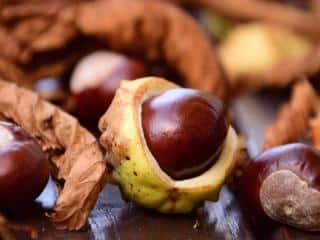

Also called conker tree, the horse chestnut tree is native to the Middle East
and to the Balkan area. It grows on any type of soil.
Imported in Europe, this tree is often found along roads, in parks, promenades and even gardens.
Belonging to the Hippocastanaceae family, this tree produces fruits that resemble chestnuts, being a dry fruit that opens its organs spontaneously to release its voluminous seeds.
Grown commercially in countries like Poland and other countries of Eastern Europe, horse chestnut is particularly recommended by doctors and herbalists for its beneficial effects on health.
But, what are its therapeutic properties? What is the best preparation and use that leads to benefiting from it in the most appropriate manner?
Here is what you need to know…
A tradition reaching back centuries, horse chestnut tree flowers, bark, seeds and leaves are used for therapeutic purposes.
In 1576, a French botanist, Charles de l’Écluse, brought a few seeds of the common horse chestnut from Constantinople. During the 2 centuries that followed this discovery, the tree spread across the entire European continent, where its ornamental value and its medicinal properties were particularly appreciated.
In the 18th century in France, specialists tried to itemize its health benefits to treat various ailments. Which ones? Let’s have a look around…
There are several well-known properties provided by the horse chestnut tree.

For centuries, preparations (extracts) from whole seeds, bark and sometimes horse chestnut leaves were used to treat diseases related to venous deficiency or poor circulation, such as cramps (especially nocturnal ones), varicose veins, swollen and heavy leg syndrome, hemorrhoids, small hematoma, baggy eyes, rosacea and even edemas.
From the 18th century onwards, horse chestnut fruits were used to treat epilepsy, chronic bronchitis, intestinal catarrhs, migraines, vertigo and even uterine bleeding.
A plant said to enhance vasoconstriction, the common chestnut tree is also recommended to:
– increase blood vessel strength by making them more permeable.
– support better cardiovascular health
– reduce disorders connected to skin and capillary frailness (bruises, petechiae…).
– soothe menstrual pain.
Traditionally, in Western Europe, it was recommended to carry or wear horse chestnuts on you to prevent lumbago, rheumatism and even bouts of gout.
Standardized extracts and topical creams prepared from horse chestnut bark, fruits o r leaves are available on the market.
 For standardized extracts, a 600 mg daily dose of horse chestnut seed extract containing 100 to 150 mg aescin is recommended.
For standardized extracts, a 600 mg daily dose of horse chestnut seed extract containing 100 to 150 mg aescin is recommended.Note: this gel must not be applied on ulcers or on skin that presents lesions.

This is why the pharmaceutical industry has been marketing aescin normalized extracts where aesculin has been removed, since the 1960s.
→ Horse chestnut tree seed extracts are contraindicated for pregnant women.
In every other case, feel free to ask your doctor about taking this herb.